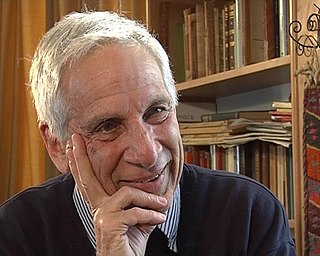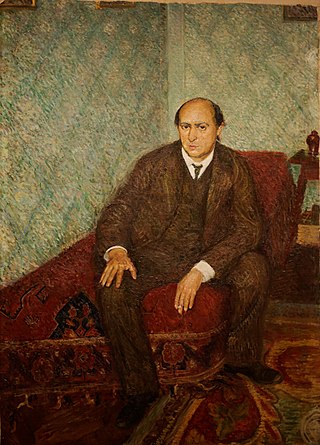Related Research Articles
Shulamit Ran is an Israeli-American composer. She moved from Israel to New York City at 14, as a scholarship student at the Mannes College of Music. Her Symphony (1990) won her the Pulitzer Prize for Music. In this regard, she was the second woman to win the Pulitzer Prize for Music, the first being Ellen Taaffe Zwilich in 1983. Ran was a professor of music composition at the University of Chicago from 1973 to 2015. She has performed as a pianist in Israel, Europe and the U.S., and her compositional works have been performed worldwide by a wide array of orchestras and chamber groups.
Joan Tower is a Grammy-winning contemporary American composer, concert pianist and conductor. Lauded by The New Yorker as "one of the most successful woman composers of all time", her bold and energetic compositions have been performed in concert halls around the world. After gaining recognition for her first orchestral composition, Sequoia (1981), a tone poem which structurally depicts a giant tree from trunk to needles, she has gone on to compose a variety of instrumental works including Fanfare for the Uncommon Woman, which is something of a response to Aaron Copland's Fanfare for the Common Man, the Island Prelude, five string quartets, and an assortment of other tone poems. Tower was pianist and founding member of the Naumburg Award-winning Da Capo Chamber Players, which commissioned and premiered many of her early works, including her widely performed Petroushskates.

Peter Alexander Goehr is an English composer and academic.
Richard Danielpour is a music professor at the University of California, Los Angeles.
Philip Cashian is an English composer. He is the head of composition at the Royal Academy of Music.
Chen Yi is a Chinese-American composer of contemporary classical music and violinist. She was the first Chinese woman to receive a Master of Arts (M.A.) in music composition from the Central Conservatory of Music in Beijing. Chen was a finalist for the 2006 Pulitzer Prize for Music for her composition Si Ji, and has received awards from the Koussevistky Music Foundation and American Academy of Arts and Letters, as well as fellowships from the Guggenheim Foundation and the National Endowment for the Arts. In 2010, she was awarded an Honorary Doctorate from The New School and in 2012, she was awarded the Brock Commission from the American Choral Directors Association. She was elected to the American Academy of Arts and Letters in 2019.
Christopher Chapman Rouse III was an American composer. Though he wrote for various ensembles, Rouse is primarily known for his orchestral compositions, including a Requiem, a dozen concertos, and six symphonies. His work received numerous accolades, including the Kennedy Center Friedheim Award, the Grammy Award for Best Classical Contemporary Composition, and the Pulitzer Prize for Music. He also served as the composer-in-residence for the New York Philharmonic from 2012 to 2015.
Michael Stern is an American symphony conductor. Currently, he serves as the music director and lead conductor of the Kansas City Symphony in Kansas City, Missouri. In 2019, he was also named the fourth music director of the Stamford Symphony in Stamford, Connecticut [now known at Orchestra LUMOS]. He is also the founding music director of the IRIS Orchestra in Germantown, Tennessee. In 2021, Stern was appointed as Music Director of the National Repertory Orchestra in Breckenridge, CO. He is only the third Music Director in the organization's history.
Chamber Symphony No. 2, Op. 38, by Arnold Schoenberg was begun in 1906 and completed in 1939. The work is scored for 2 flutes, 2 oboes, 2 clarinets, 2 bassoons, 2 horns, 2 trumpets and strings, and is divided into two movements, the first marked Adagio and the second marked Con Fuoco-Lento. The work's belated completion was prompted by the conductor Fritz Stiedry, who asked Schoenberg for an orchestral piece for his New Friends of Music Orchestra in New York. The work was first performed there on December 14, 1940, under Stiedry's direction.
Fenwick Smith was an American flutist. He studied under Joseph Mariano at the Eastman School of Music, graduating from there in 1972. Shortly thereafter he became a member of the New England Woodwind Quintet and began a thirteen-year membership with Boston Musica Viva. He became the assistant principal flutist of the Boston Symphony Orchestra in 1978, serving in that position until September 2006. During this time he was also principal flutist of the Boston Pops Orchestra. Smith was also a member of the Boston Chamber Music Society since 1984, and since 1983 gave annual recitals at Jordan Hall.

Kati Ilona Agócs is a Canadian-American composer and a member of the composition faculty at the New England Conservatory of Music in Boston, Massachusetts.
Michael Schelle, born January 22, 1950, in Philadelphia, is a composer of contemporary concert music. He is also a performer, conductor, author, and teacher.

The Chamber Symphony No. 1 in E major, Op. 9 is a composition by Austrian composer Arnold Schoenberg.
David Schiff is an American composer, writer and conductor whose music draws on elements of jazz, rock, and klezmer styles, showing the influence of composers as diverse as Stravinsky, Mahler, Charles Mingus, Eric Dolphy and Terry Riley. His music has been performed by major orchestras and festivals around the United States and by soloists David Shifrin, Regina Carter, David Taylor, Marty Ehrlich, David Krakauer, Nadine Asin and Peter Kogan. He is the author of books on the music of Elliott Carter, George Gershwin and Duke Ellington. His work has been honored by the League-ISCM National Composers Competition award and the ASCAP-Deems Taylor award for his book on Elliott Carter.
Adam Schoenberg is an American composer. A member of the Atlanta School of Composers, his works have been performed by numerous orchestras and ensembles in the U.S. Schoenberg was the 2010-2012 guest composer for the Aspen Music Festival, the 2012-2013 composer-in-residence for the Kansas City Symphony, the 2013-2014 composer-in-residence for the Lexington Philharmonic, and the 2015-2017 composer-in-residence for the Fort Worth Symphony. Schoenberg's honors include a 2009 and 2010 MacDowell Colony fellowship, the 2007 Morton Gould Young Composer Award from ASCAP, and the 2006 Charles Ives Prize from the American Academy of Arts & Letters.
Chamber Symphony is a 1992 composition for a 15-member chamber orchestra by American composer John Adams, inspired by Arnold Schoenberg's Chamber Symphony No. 1, Op. 9. It is a three-movement work that takes about 23 minutes to perform.
Jonathan Leshnoff is an American classical music composer and pedagogue.
The American Symphony is a symphony for orchestra by the American composer Adam Schoenberg. The work was commissioned by the Kansas City Symphony and was completed in early 2011. It was first performed by the Kansas City Symphony under the direction of Michael Stern at the Kauffman Center for the Performing Arts in Kansas City on March 4, 2011.
Picture Studies is an orchestral suite by the American composer Adam Schoenberg. The work was commissioned by the Kansas City Symphony and the Nelson-Atkins Museum of Art. It was first performed by the Kansas City Symphony conducted by Michael Stern at the Kauffman Center for the Performing Arts in Kansas City on February 1, 2013.
Matthew Ricketts is a Canadian composer of contemporary classical music. He is a 2019 Guggenheim Fellow as well as the recipient of the 2020 Charles Ives Fellowship from the American Academy of Arts and Letters, the 2016 Jacob Druckman Prize from the Aspen Music Festival, the 2015 Salvatore Martirano Memorial Composition Award, a 2013 ASCAP Foundation Morton Gould Young Composer Award, and eight prizes in the SOCAN Foundation's Awards for Young Composers. He lives in Brooklyn, New York.
References
- ↑ "American Symphony - Finding Rothko - Picture on Discogs".
- 1 2 Schoenberg, Adam (2006). Program Notes: Finding Rothko. Retrieved August 28, 2017.
- ↑ Steiman, Harvey (July 19, 2011). "Spano's Program an Enticing Taste of the Festival's Future?". The Aspen Times . Retrieved August 28, 2017.
- ↑ Neas, Patrick (June 7, 2014). "Kansas City Symphony prepares to record Adam Schoenberg's work". The Kansas City Star . Retrieved August 28, 2017.
- ↑ Neas, Patrick (July 1, 2017). "Four new classical CDs, including one by KC Symphony, worth a listen". The Kansas City Star. Retrieved August 28, 2017.
- ↑ Castillo, Patrick (February 27, 2017). "Rothko and Americana Inspire Orchestral Works of Adam Schoenberg". WQXR-FM . Retrieved August 28, 2017.